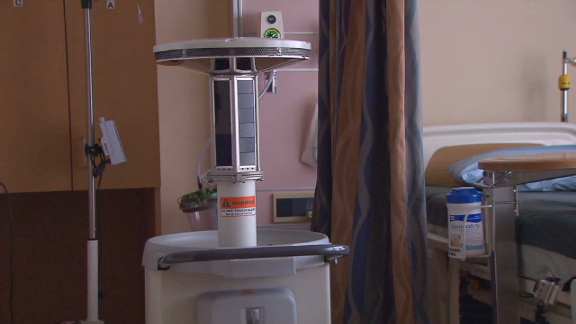It subsequently saw a 67% drop in infections from C. diff
Hospitals are supposed to be the place where the sick get well. They can also be where the sick get sicker, thanks to the virulent bacteria and viruses that live there.
At any given time, 1 in 20 hospital patients is battling an infection that they got on site, according to the Centers for Disease Control. Hospitals now pay greater attention to hand hygiene — Purell dispensers have become ubiquitous — but their main infection control methods haven’t changed much for decades. Most rooms are still disinfected by housekeepers armed with chemical cleaners.
Enter the Xenex, a mobile, robotic device that combats germs with blasts of light. It looks like Star Wars’ R2D2 with a handle, but it’s a killing machine — if you’re a microorganism. Set it loose in a hospital room and it will chirp and click its way through a cleaning routine of strobe-like pulses. Those flashes are what’s called “pulsed xenon UV,” a type of ultraviolet light that sterilizes and kills microbiological contaminants.
Epidemiologists Julie Stachowiak and Mark Stibich developed the technology that powers the Xenex at the Houston Technology Center. To commercialize the system, they needed to build a business. That’s where Brian Cruver, a former Enron trader, came in. After starting his career at the company that became infamous for its corruption — a story Cruver told in the book Anatomy of Greed — Cruver shifted his career toward entrepreneurship.
“I wanted to get involved with ventures that did some good,” he says.
Cruver joined Xenex in 2009 as the company’s CEO. The Austin-based venture now has 30 employees and has raised about $5 million from investors.
The Xenex disinfects a hospital room in about five to 10 minutes, focusing on high-touch surfaces like tray tables, telephones, and bedrails. After housekeepers finish cleaning a room, they wheel the machine in and hit go. “It’s easier to use than a vacuum cleaner,” Cruver says.
Watch the Xenex robot in action
It also works. At Cooley Dickinson Hospital in Northampton, Mass., 1 in 129 patients came down a hospital-acquired infection in 2010. Last January, Cooley began using the Xenex device. It subsequently saw a 67% drop in infections from C. diff, a toxic superbug that can cause diarrhea, sepsis and death.
Bookmark this page for “robot cleaner” and check back regularly as these articles update on a frequent basis. The view is set to “news”. Try clicking on “video” and “2” for more articles.








